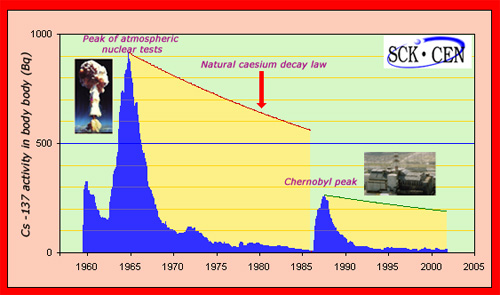Becquerel or Bq : the activity unit of a radioactive source

The Becquerel: a very small unit…:
The becquerel, the today unit of activity, corresponds to a decay rate of one nucleus per second. This extremly small atomic scale unit is so small (and therefore ill-adapted to the activities of most radioactive substances) that multiples of becquerels are frequently used: kilo (thousands), mega (millions), giga (billions) and terabecquerels (thousands of billions), etc. The diagram above shows the range of activities that different substances – from a litre of water up to the spent fuel extracted from the core of nuclear reactors – can have. Historic units curies and millicures have also been indicated.
© IN2P3
The activity of a sample of matter which contains radioactive nuclei is one of the intrinsic properties of this radioactive source. It represents the number of decays occurring every second or, alternatively, the number of rays emitted. In this latter case, we talk about alp
of a sample of matter which contains radioactive nuclei is one of the intrinsic properties of this radioactive source. It represents the number of decays occurring every second or, alternatively, the number of rays emitted. In this latter case, we talk about alp ha, beta
ha, beta and gamma
and gamma radiation. The activity of a source does not take into account the nature or the energy of the radiation, nor the effects such rays would have in different media.
radiation. The activity of a source does not take into account the nature or the energy of the radiation, nor the effects such rays would have in different media.
The activities of different sources were for many years expressed in units known as curies (Ci). The radiations emitted by radioactive substances were measured by a comparison with a standard, the radiation emitted by radium, the radioactive element found by Marie Curie. One curie corresponded to the activity of one gram of radium, or 37 billion disintegrations per second. Given this very high value of one curie, millicuries or microcuries were more commonly used.
Physicists and engineers have since adopted a more logical unit – the Becquerel – which corresponds to a decay rate of one per second. The associated inconvenience, however, is that the Becquerel is a very small unit, adapted to the scales of the atom. Activities expressed in becquerels therefore lead to misleadingly large numbers, which can cause confusion among non-specialists. For example, the human body has an activity of 8000 Bq – a value which may seem high but is in reality very small. It corresponds a few microcuries.
Seeing activities written down in becquerels often gives the impression that such activities are exceptionally high and thus very dangerous. This is mainly due to the small value of a Becquerel, and substances are rarely that dangerous. The Becquerel is like the Deutschmark used by the Weimar republic in the 1920s when a wheelbarrow of marks was needed to buy a croissant.

Evolution of caesium 137 activity in the human body
The activity of caesium 137 in the human body has been measured near the Mol laboratory in Northern Belgium for more than half a century. Despite the laboratory large distance from nuclear tests bomb sites and Chernobyl, the peaks of activity due to these tests and the Chernobyl accident (four times weaker) can be seen. In these two cases, the caesium 137 in the human body occurs much more quickly than the natural decay, which has a half-life of 30 years. Despite the slow caesium absorption by the ground, its fast activity decrease in the human body means that no soil decontamination was needed.
© SCK-CEN
In the rational and cartesian countries lof the western world, it was logical to define the basic unit of activity as one disintegration per second. But men of science could be awkward psychologists. The choice of the becquerel has revealed itself to be a public relations disaster. The tiniest levels of activity expressed in becquerels are represented by tremendously high numbers, which feed the insecurity of the public.
Other articles on the subject « Radioactive Doses »
Absorbed doses
Gray or Gy : unit of energy deposited in matter by radiation The ‘absorbed dose’ is defined as th[...]
Biological doses
Sievert (Sv) : the unit of doses for the living The energy deposited in a living organism by radi[...]
Equivalent Dose
A local biological dose The concept of the “equivalent dose” which takes into account[...]
Effective Dose
A full-body dose, central in the field of radioprotection The “effective dose” is a b[...]
MilliSievert
A unit for low doses of radioactivity After a nuclear accident or accident of radioactivity, it i[...]
Dose Scale
A dose classification for acute exposures When dealing with exposure to radiations, what do we me[...]